
Developing Robots for Daily Life
A robot running around with children, a robot playing a musical instrument, a robot missing the bus--robots have recently begun to appear on television commercials and at event sites in Japan, where research and development of humanoid robots is active and advanced. And not only researchers but an increasing number of amateurs, too, are enthusiastic about making robots. In this issue we report on the robot scene in Japan.
What is a Robot?
The
word "robot," derived from the Czechoslovakian word robota (worker), was
first used in the play "R.U.R." (Rossum’s Universal Robots) first performed in
Czechoslovakia in 1920. Robots appeared in the play as artificial humans who
function only as workers. A robot in female guise appeared in "Metropolis," a
movie made in Germany in 1927. Both "R.U.R." and "Metropolis" were box office
hits, firmly establishing the idea of the robot (a humanoid machine that works
for human beings) in the popular consciousness.
Exactly what a robot is, nevertheless, is
not clearly defined. Devices called "robots" today are extremely diverse in both
shape and function. For example, the robots that work in manufacturing plants
mainly perform a certain task programmed into them by human operators and are
usually shaped something like a human arm. Robots that help with rescue operations
at disaster sites include those that move away debris and other obstacles through
manipulation via remote control, as well as self-controlled robots that can get
around obstacles in their path and search for victims, thus assessing the situation
and acting accordingly.
Roles of Robots
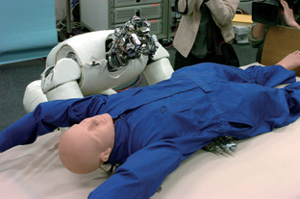 <- © Prof.
Kuniyoshi Yasuo, Dept. of Mechano-Informatics, Grad. School of Information Science
and Technology, The Univ. of Tokyo
<- © Prof.
Kuniyoshi Yasuo, Dept. of Mechano-Informatics, Grad. School of Information Science
and Technology, The Univ. of Tokyo
What do people expect of robots?
One area of expectations is in working in place of human beings. Industrial robots
take over some jobs in manufacturing. There are also robots that perform dangerous
tasks in disaster areas and in the deep sea. Progress is being made in developing
robots for daily life to help out with jobs such as carrying heavy things or
moving bedridden patients from one bed to another.
Attention has turned recently to robots that
recognize and respond to human speech and can be part of people’s daily lives.
If you were
asked to develop a robot, what kind of robot would you like to make? What do
you think the future holds for the relationship between human beings and robots?
It is a subject really quite fascinating to think about.
| Chronology of Robots in Japan | |
|---|---|
| 1960s | (Creation of the world’s first industrial robot in the United States) - Industrial robots imported to resolve labor shortage in the manufacturing industry - Beginning of industrial robot R&D in Japan |
| 1970s | Industrial robot production figure in Japan highest in world |
| 1980s | - More than 19,000 industrial robots manufactured* - About 70 percent of the industrial robots in use worldwide are operating in Japan.** - Advances in artificial intelligence - First Technical College Robocon held (1988) |
| 1990s | - More than 79,000 industrial robots manufactured* - First University Robocon held (1991) - Honda announces creation of two-legged humanoid robot P2 (1996) - Sony announces creation of four-legged robot AIBO (1997) - First RoboCup soccer match held (1997) - Sony markets the AIBO robot for the consumer market at ¥250,000; 3,000 units sold out in 20 minutes (1999) |
| 2000 first decade | - More than 89,000 industrial robots manufactured* - Honda announces creation of first model of ASIMO robot (2000) - First ROBO-ONE held (2001) - First ABU Robocon held (2002) - Toyota Partner Robot shown at Aichi Expo (2005) |
Sources: *Japan Robot Association; **International Federation of Robotics, National Robot Associations, and UNECE
Animation and Robots
What images and functions come to mind when you hear the word "robot"? The heroes of quite a few well-known Japanese cartoons are robots. There is Astro Boy (Tetsuwan Atomu), created by Japan’s most famous twentieth-century cartoonist, Tezuka Osamu. Popular all over the world even today is Doraemon, the robotic cat that thinks and acts like a human being. All sorts of robots figure in Japanese animation, including giant robots like Gigantor (Tetsujin Nijuhachi-go) and Mazinga Z (Majinga Z) that are controlled by humans. Because of the associations created by these animation heroes, Japanese often think of robots as friends or heroes, and not a few people began developing robots because of the inspiration of such cartoon characters. The engineer who developed the world’s first two-legged robot, ASIMO, says that when the assignment began, his boss said, "I want you to make Astro Boy." The same idea, reported the creator of AIBO, was behind the four-legged robot that is capable of learning through communication with humans.
Manufacturing
ものをつくる
 The vast majority of robots in use today are industrial robots that have been employed for more than 40 years in automobile and precision-equipment manufacturing plants. As of the end of 2005, about 40 percent of the more than 920,000 industrial robots in use worldwide were at work in Japan.
The vast majority of robots in use today are industrial robots that have been employed for more than 40 years in automobile and precision-equipment manufacturing plants. As of the end of 2005, about 40 percent of the more than 920,000 industrial robots in use worldwide were at work in Japan.
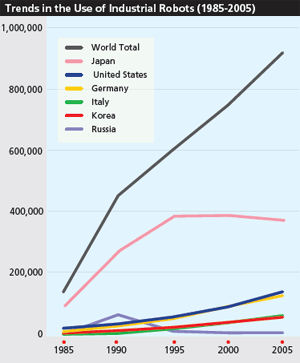
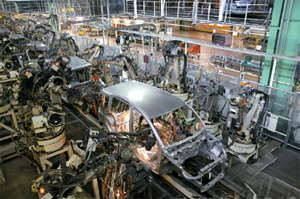
© Toyota Motor Corporation
<- Source: International Federation of Robots
Rescue Work
救助(きゅうじょ)する
 The day is not far off when robots will play an important role in disaster zones and other dangerous situations.
The day is not far off when robots will play an important role in disaster zones and other dangerous situations.T-52 Enryu
Rescuing victims trapped in collapsed buildings is dangerous work that also requires great strength, so hydraulically-operated robots like this are indispensable. They can be operated by remote control or directly controlled by a driver seated inside the vehicle.
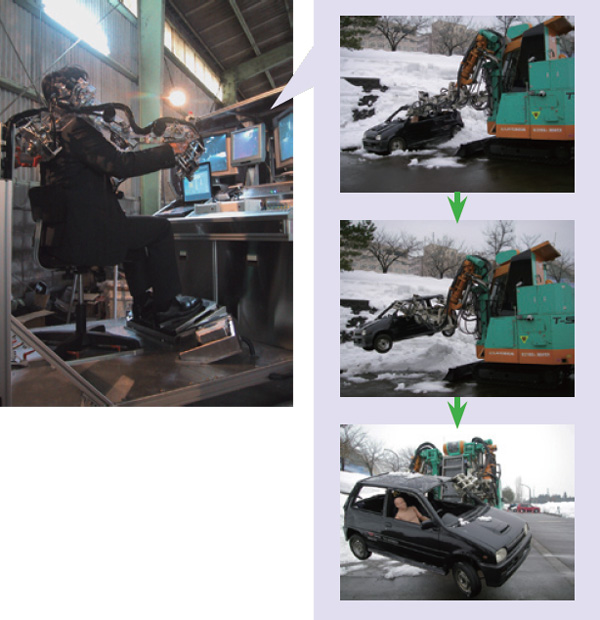
© 2004 tmsuk Co.,LTD
Kohga, Kohga2
This snake-like robot can crawl into the ruins of broken buildings to locate victims. A fact-finding robot can explore inside partially destroyed structures and underground passages.
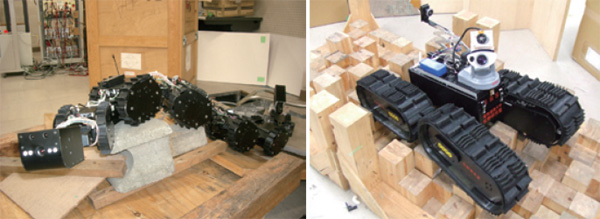
© Matsuno Lab. at the University of Electro-Communications
Part of Daily Life
人(ひと)とくらす
 Robots that play various roles in our daily lives are now drawing great interest.
Research and development of humanoid and communicative robots is currently very active.
Robots that play various roles in our daily lives are now drawing great interest.
Research and development of humanoid and communicative robots is currently very active.HRP2-JSK
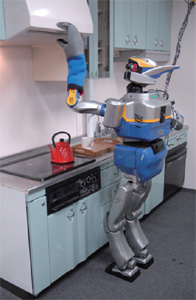 In 2007, University of Tokyo’s Jouhou System Kougaku Laboratory (Department
of Mechano-Informatics, Graduate School of Information Science and Technology)
gave a demonstration of HRP2-JSK, an improved version of the HRP-2 prototype, that will perform household tasks. HRP-2 was developoed by the New Energy and Industrial Technology Development Organization (NEDO), Japan’s largest public R&D management organization supported by the Ministry of Economy, Trade and Industry.
In 2007, University of Tokyo’s Jouhou System Kougaku Laboratory (Department
of Mechano-Informatics, Graduate School of Information Science and Technology)
gave a demonstration of HRP2-JSK, an improved version of the HRP-2 prototype, that will perform household tasks. HRP-2 was developoed by the New Energy and Industrial Technology Development Organization (NEDO), Japan’s largest public R&D management organization supported by the Ministry of Economy, Trade and Industry.
PaPeRo
Developed by NEC, PaPeRo was created as a personal robot to be part of a household as a companion to family members. Special attention has been given to how it can make gestures and talk in communicating with humans. It can recognize the voices of up to 10 persons. The designers hope to create a robot that will help take care of children at daycare centers, kindergartens, and elementary schools.
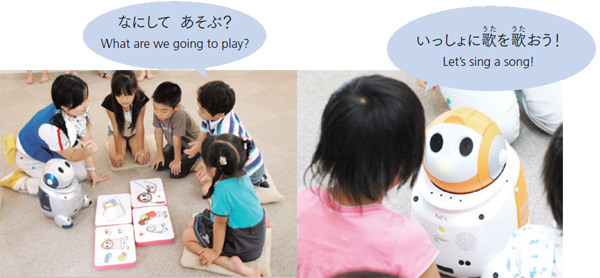
© 2001-2007 NEC Corporation
Partner Robot
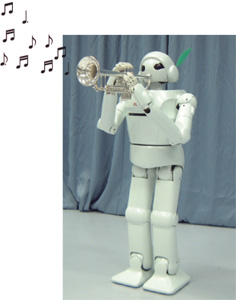 This robot was developed by Toyota. Equipped with artificial lips imitating the movement of human lips, it can play the trumpet.
This robot was developed by Toyota. Equipped with artificial lips imitating the movement of human lips, it can play the trumpet.
PARO
PARO was researched and developed as a mental care robot designed to realize the therapeutic benefits of pets in relieving stress and promoting communication. It was first used in medical welfare institutions for children and elderly around 2000. Today some 1,000 PAROs worldwide are providing therapeutic comfort as animal substitutes in households as well as in environments such as hospitals where pets cannot be permitted.
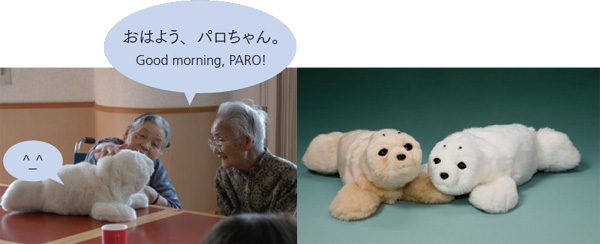
© National Institute of Advanced Industrial Science and Technology
ASIMO
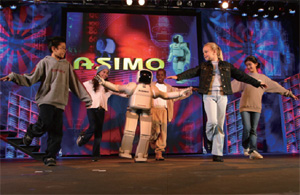 The pioneer humanoid robot is ASIMO, introduced by Honda in 2000. Its performance improves each year. It can now run and walk pushing a cart.
The pioneer humanoid robot is ASIMO, introduced by Honda in 2000. Its performance improves each year. It can now run and walk pushing a cart.
You can see short film clips of ASIMO running around with children, walking around a museum and showing surprise at things it sees at the following site:
http://www.honda.co.jp/ASIMO/gallery/
Reborg-Q
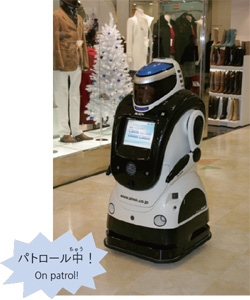 Equipped with four cameras front, back, right and left, and with sensors that can detect fire and water leakage, the Reborg-Q automatically patrols a pre-mapped path through a building and can monitor certain conditions by remote control. In Tokyo, these security robots were put into use at Aqua City Odaiba starting in December 2006.
Equipped with four cameras front, back, right and left, and with sensors that can detect fire and water leakage, the Reborg-Q automatically patrols a pre-mapped path through a building and can monitor certain conditions by remote control. In Tokyo, these security robots were put into use at Aqua City Odaiba starting in December 2006.
Original Robot Tournaments
 Not only specialists at manufacturing companies and research institutes but amateurs and hobbyists, too, have grown increasingly involved in building original robots. A number of competitions designed to stimulate
the advance of robot technology draw widespread interest.
Not only specialists at manufacturing companies and research institutes but amateurs and hobbyists, too, have grown increasingly involved in building original robots. A number of competitions designed to stimulate
the advance of robot technology draw widespread interest.RoboCup
Competitions in two main divisions, featuring soccer and rescue operations, have been held annually since 1997. The objective in the soccer division is to "develop a team of humanoid robots that can win against the human world soccer champion team" by the year 2050. The rescue division goal is to form a rescue team of automated robots—Robots Without Borders—that can be sent in to help wherever disasters occur. The "RoboCupJunior" is a similar tournament for elementary school students and other people interested in making robots.

© The RoboCup Federation
ROBO-ONE
The "combat tournament" among two-legged humanoid robots begun in 2001 is aimed to "popularize the enjoyment of robots," and emphasizes outstanding technological innovation and entertainment qualities. Division play-offs are held according to a chosen theme and in the finals the goal is to knock the opponent out of the ring. A tournament is planned to take place in outer space on October 10, 2010.
Robocon (see Meeting People)
The rules of the tournament change each year but basically involve manipulation of remote-controlled robots. Competing with original ideas and technology-advancing innovations, the robots win points for successfully carrying balls, blocks, or other items over a prescribed course. Begun in 1988 with the technical college-centered tournament, it expanded to a contest among universities in 1991. The ABU Robocon began in 2002, a competition among students of universities and engineering colleges representing the member countries and regions of the Asia-Pacific Broadcasting Union (ABU). Japan sends winner of its university-level Robocon as its representative to the ABU Robocon.
Robot Kits on Sale
 Nowadays it is easy to purchase simple robot-making kits. Designed for home assembly, these kits are based on robots that won prizes at various robot tournaments. There are shops specializing in robots and robot parts and even classes are offered giving guidance in building and creating robots.
Nowadays it is easy to purchase simple robot-making kits. Designed for home assembly, these kits are based on robots that won prizes at various robot tournaments. There are shops specializing in robots and robot parts and even classes are offered giving guidance in building and creating robots.KHR-1HV
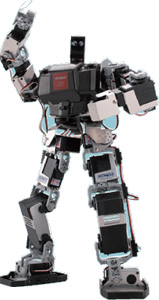 The 2004 ROBO-ONE J-class winning robot was the proto-
type for this commercially sold robot. Software for easily programmable
robot movement is part of the kit, allowing even beginners to get a taste of the fun of robot making. This robot was a great hit at one point because it was sold at extremely low prices. ¥124,000 (tax included).
The 2004 ROBO-ONE J-class winning robot was the proto-
type for this commercially sold robot. Software for easily programmable
robot movement is part of the kit, allowing even beginners to get a taste of the fun of robot making. This robot was a great hit at one point because it was sold at extremely low prices. ¥124,000 (tax included).

ATR/VSTONE Robovie-i
Beginners’ robot designed to be handled by anyone with ease. Can be stepped up to walk on two legs. Movements are made possible with special software. ¥29,400 (tax included). VSTONE also put on the market a robot for research use, based on a RoboCup world competition-winning robot.
© ATR ->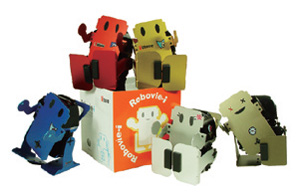
Tsukumo Robot Kingdom
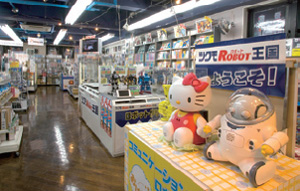 Japan’s first robot specialty store opened in 2000 in Tokyo.
Japan’s first robot specialty store opened in 2000 in Tokyo.
Original text : Takarabako No.12 “Japanese
Culture Now” June
2007.
Copyright(C)1997-2008 The Japan Forum. All rights reserved.
Send feedback to forum@tjf.or.jp